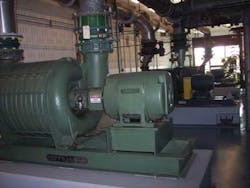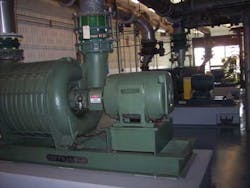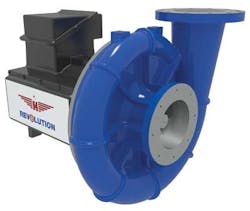By Justin Rundle
Upgrading to the latest aeration system or blower technology is not as simple or convenient as upgrading to the latest iPhone. Initial costs can be a burden for smaller wastewater treatment plants (WWTPs), as well as plants operating on tight budgets. However, because aeration systems typically account for 45 to 75 percent of a plant's total energy consumption, upgrading to more energy-efficient technologies can help cut operating costs.
Plant managers should examine potential benefits before making any decisions. One early step is to calculate simple payback as a first-cut assessment to see if the payback period makes sense before engaging a systems integrator for a more thorough assessment.
Before discussing simple payback, it's important to first understand how an aeration system functions and the different types of aeration systems available. WWTPs typically use either surface or submerged aeration systems to facilitate the activated sludge process. Submerged aeration systems typically use blowers to compress air and transfer oxygen into the wastewater through diffusers mounted on the basin floor. The oxygen transfer supports the aeration process within the basin.
In contrast, surface aeration systems are installed on the water's surface and use rotating brushes or disks to transfer air into the water. Surface aerators cost less to install when compared to submerged systems. However, surface systems have a higher lifetime operating cost due to lower oxygen transfer efficiencies.
WWTPs using submerged systems also typically employ either positive displacement blowers or multi-stage centrifugal blowers to transfer air from the surface to beneath the water. These technologies were state of the art for many years. However, recent advancements have superseded the efficiency of traditional blowers.
The next generation of aeration blowers is 10 to 20 percent more energy efficient than previous systems. These new blowers are called high-speed centrifugal blowers or turbo blowers. They operate at 10,000 to 60,000 rotations per minute while traditional blowers operate within the range of 900 to 3,600 rpm. The higher speeds are achieved by using gear increases, air bearings or magnetic bearings. Air and magnetic bearing are a recent technology breakthrough.
A significant advantage of turbo blowers is the ability to maintain efficiency when wastewater flows are lower. For example, a plant may require 90 percent of the maximum rated flow of a blower system during peak flows and may only require 45 percent under normal operating conditions. Most turbo blowers have integrated variable frequency drives to scale down the blower and improve energy efficiency during low-flow times. These blowers can also modulate blower output in response to signals from dissolved oxygen sensors, allowing the air flow to meet the changing conditions of a WWTP automatically throughout the day.
The improved efficiency of these blowers, even without a dissolved oxygen (DO) sensor, helps reduce energy costs, enabling WWTPs to pay for the blower upgrades within 3 to 10 years on average, depending on the size of the WWTP and application.
Calculating Simple Payback
Plant managers should weigh their options and decide whether investing in newer blower technology would benefit the plant. Upgrading to a new and more energy-efficient aeration system can be expensive, but the subsequent savings can pay for the improvements. The key is to calculate simple payback to help better understand the potential financial benefits and then use this information to decide if upgrading makes sense.
Let's create a scenario for a WWTP to best illustrate how to calculate simple payback. Assume the following for this example:
- The WWTP has three 250 horsepower multi-stage centrifugal blowers.
- One blower operates full time, the second blower operates for 12 hours per day for six months per year and the third is a stand-by unit.
- The blowers do not have variable frequency drives or DO sensors to control output.
- The blended electrical rate for the plant is 12.4 cents per kilowatt-hour (kWh).
- Motor loading is 75 percent and motor efficiency is 95 percent.
- Installing a single high-speed, 200 HP turbo blower will cost about $220,000 and reduce energy consumption by 20 percent.
Under these assumptions we can calculate that the WWTP spends about $160,000 per year in energy costs to operate the lead blower (250 HP x 0.746 kW (the standard rate for converting HP to kW) x 24 hours / day x 365 days / year x 0.75 loading / 0.95 efficiency x 12.4 cents per kWh). This WWTP could potentially save about $32,000 per year if a high-speed blower is installed ($160,000 x 20%).
The simple payback for replacing this blower would be about seven years without utility incentives ($220,000 initial cost / $32,000 annual savings). Many electric utilities, however, offer incentives that can improve the simple payback, making the blower upgrade project even more attractive.
Replacing the old blower system should be considered a good investment in this scenario because the equipment can be paid for within seven years after installation. High-speed blowers typically have an expected useful life of 25 years, enabling the WWTP to benefit from the cost savings for the remaining 18 operating years of the system.
Weighing Your Options
Energy costs continue to rise and plant managers should act proactively to meet this challenge. Calculating simple payback can help plant managers illustrate the potential financial benefits they can achieve from replacing traditional aeration systems and blowers with more energy efficient solutions.
About the Author: Justin Rundle, PE, CEM, CCM, LEED-AP, is an energy engineer at Honeywell Energy and Environmental Solutions, a national energy services company. Rundle is a licensed WWTP operator and construction contractor in Arizona. With 25 years experience in the construction and engineering industry, he specializes in evaluating and developing energy efficiency measures at water and wastewater treatment plants. For questions or comments regarding this article, or for a "free" energy assessment at your WWTP, contact Rundle at [email protected].





